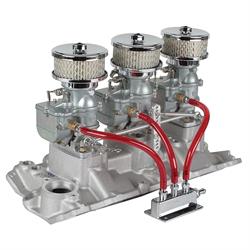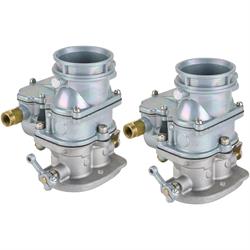How To Set Up Multiple Carburetors on a Vintage Engine
Two Carbs
If you plan on running two two-barrel carburetors, both of them should be primary carburetors. Primary carburetors are designed with idle mixture circuits and choke assemblies. By using primary carburetors on a two-carb setup, you will ensure even fuel distribution to your engine.
Three Carbs
When running a three-carb setup, you typically want to use one primary carburetor in the center and two secondary carbs on the ends. This will allow your engine to use the primary carb with choke for idle and part-throttle operation. It gives the engine’s entire vacuum signal to one carburetor, ensuring good fuel distribution. When set up with a progressive throttle linkage, such as Speedway part number 5606271, this type of three-carb system will operate like a modern four-barrel carburetor: idle and cruise on just two barrels, with the secondary carbs letting in more air and fuel as the engine needs it. If you try to use three primary carburetors, it will be difficult for each one to get a proper vacuum signal or supply the correct air/fuel mixture. This causes the engine to load up at idle and foul plugs. Remember, you should always use a second return spring on the secondary carburetor to hold them shut until they are needed.


